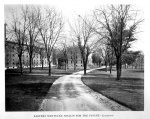Difference between revisions of "Portal:Featured Article Of The Week"
M-Explorer (talk | contribs) |
M-Explorer (talk | contribs) |
||
| Line 1: | Line 1: | ||
{{FAformat | {{FAformat | ||
| − | |Title= | + | |Title= Eastern State Hospital Lexington |
| − | |Image= | + | |Image= Esho2.jpg |
|Width= 150px | |Width= 150px | ||
| − | |Body= | + | |Body= On February 15, 1816, the Kentucky General Assembly passed an act establishing a public hospital in Fayette County. The act incorporated a group of citizens, the “Contributors of the Fayette Hospital,” who wished to erect a building at their own expense to serve as a hospital for the accommodation of “lunatics” as well as other “sick poor.” The act gave the Contributors the right to establish a committee, elect officers, raise money to purchase a piece of land in or near Lexington, and to contract for the construction of a building to serve as the hospital (An act for founding, 1816). The Contributors meet on March 1, 1816 and elected a building committee consisting of Andrew McCalla, Sterling Allen, Stephen Chipley, Thomas January,and Richard Higgins. McCalla was appointed chairman (Fayette Hospital, 1816). In an open letter in the Kentucky Reporter on April 17, 1816, the Committee presented their mission and asked for assistance. They noted that there were many “poor, disabled, and infirm members of society” without the aid of medicine who with the assistance that could be provided by a “Public Hospital,” might become useful to themselves, their families, and society. They also noted that “lunatics,” who have no “rich relatives” to care for them, “roam at large through the country...” and in many instances “endanger the lives of other members of society.” The best remedy, they suggested, was the erection of a public hospital. They argued that the hospital was not only their best chance at a cure but also a means by which physicians could acquire “superior skill” by treating them. Finally, they declared that “society itself would be made more secure against the wild and desperate actions of lunatics, if provision was made to contain them within its walls.” The Committee concluded the letter by requesting that “ALL” people of Kentucky contribute to the support of the hospital (To the people of Kentucky, 1816). |
| − | + | Their early efforts must have been effective for not long after their incorporation, the Building Committee purchased the “Sinking Spring” property on which the present hospital now stands (Perrin 1882: 391). On June 30, 1817, the corner-stone of the “Fayette Hospital” building was laid in the presence of a large group of spectators. [[Eastern State Hospital Lexington|Click here for more...]] | |
| − | |||
| − | |||
| − | |||
}} | }} | ||
Revision as of 03:42, 30 January 2012
Featured Article Of The Week
Eastern State Hospital Lexington
On February 15, 1816, the Kentucky General Assembly passed an act establishing a public hospital in Fayette County. The act incorporated a group of citizens, the “Contributors of the Fayette Hospital,” who wished to erect a building at their own expense to serve as a hospital for the accommodation of “lunatics” as well as other “sick poor.” The act gave the Contributors the right to establish a committee, elect officers, raise money to purchase a piece of land in or near Lexington, and to contract for the construction of a building to serve as the hospital (An act for founding, 1816). The Contributors meet on March 1, 1816 and elected a building committee consisting of Andrew McCalla, Sterling Allen, Stephen Chipley, Thomas January,and Richard Higgins. McCalla was appointed chairman (Fayette Hospital, 1816). In an open letter in the Kentucky Reporter on April 17, 1816, the Committee presented their mission and asked for assistance. They noted that there were many “poor, disabled, and infirm members of society” without the aid of medicine who with the assistance that could be provided by a “Public Hospital,” might become useful to themselves, their families, and society. They also noted that “lunatics,” who have no “rich relatives” to care for them, “roam at large through the country...” and in many instances “endanger the lives of other members of society.” The best remedy, they suggested, was the erection of a public hospital. They argued that the hospital was not only their best chance at a cure but also a means by which physicians could acquire “superior skill” by treating them. Finally, they declared that “society itself would be made more secure against the wild and desperate actions of lunatics, if provision was made to contain them within its walls.” The Committee concluded the letter by requesting that “ALL” people of Kentucky contribute to the support of the hospital (To the people of Kentucky, 1816).
Their early efforts must have been effective for not long after their incorporation, the Building Committee purchased the “Sinking Spring” property on which the present hospital now stands (Perrin 1882: 391). On June 30, 1817, the corner-stone of the “Fayette Hospital” building was laid in the presence of a large group of spectators. Click here for more...
